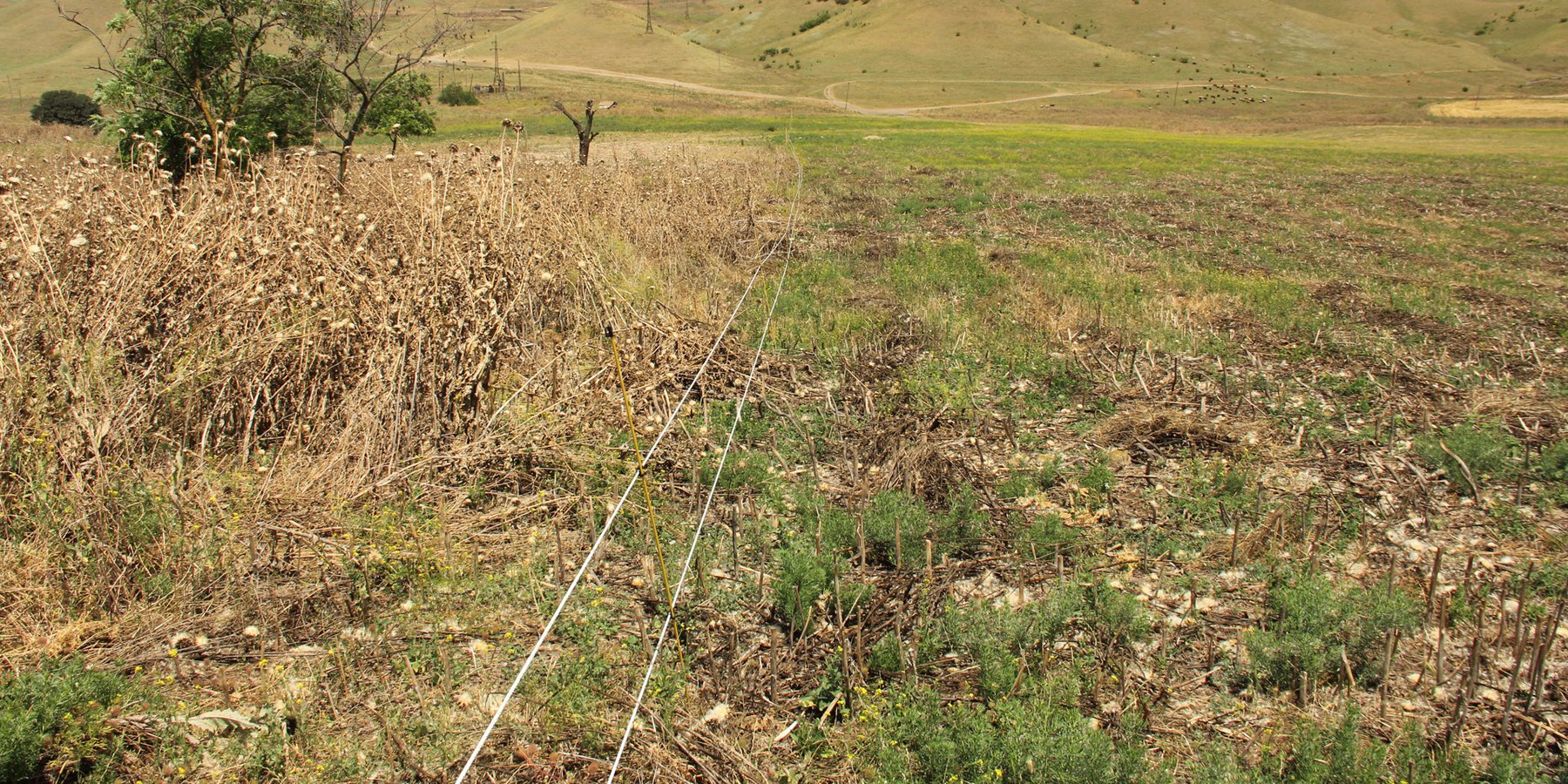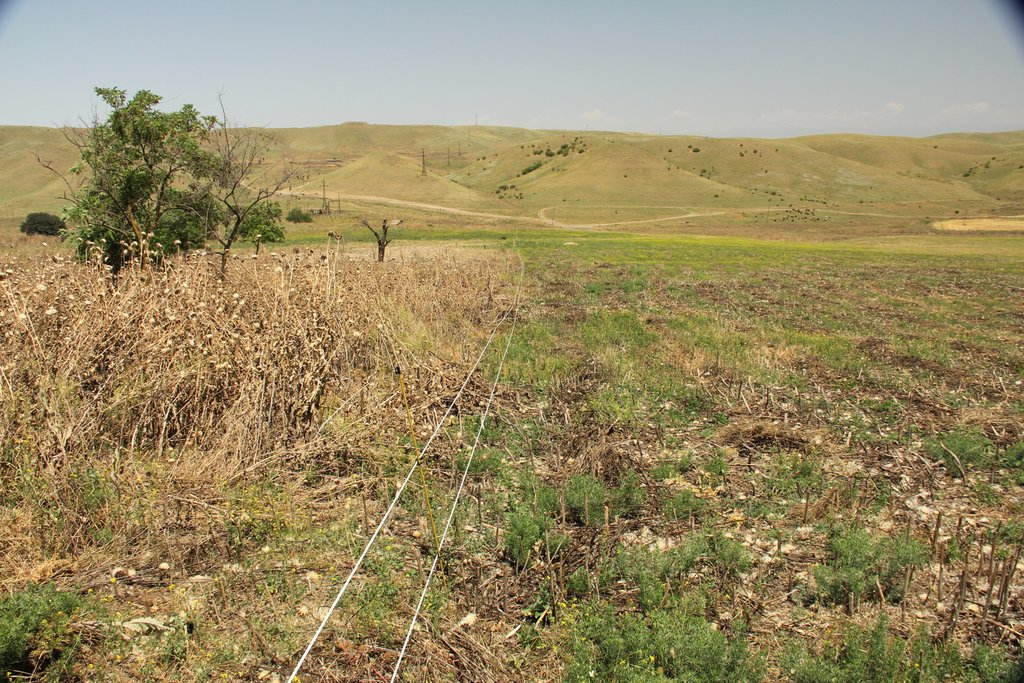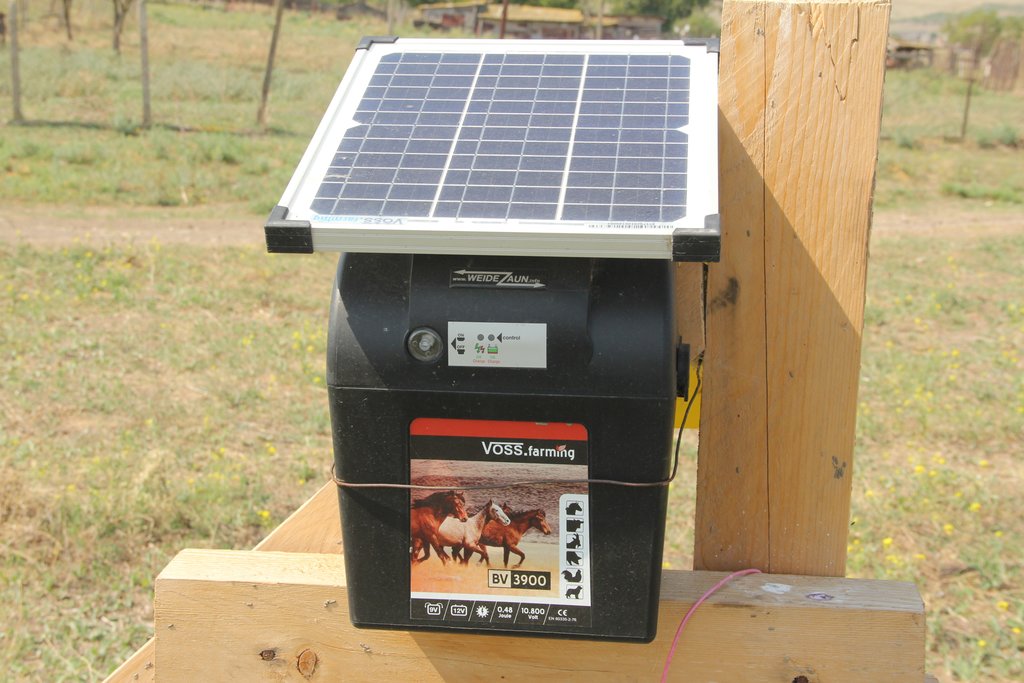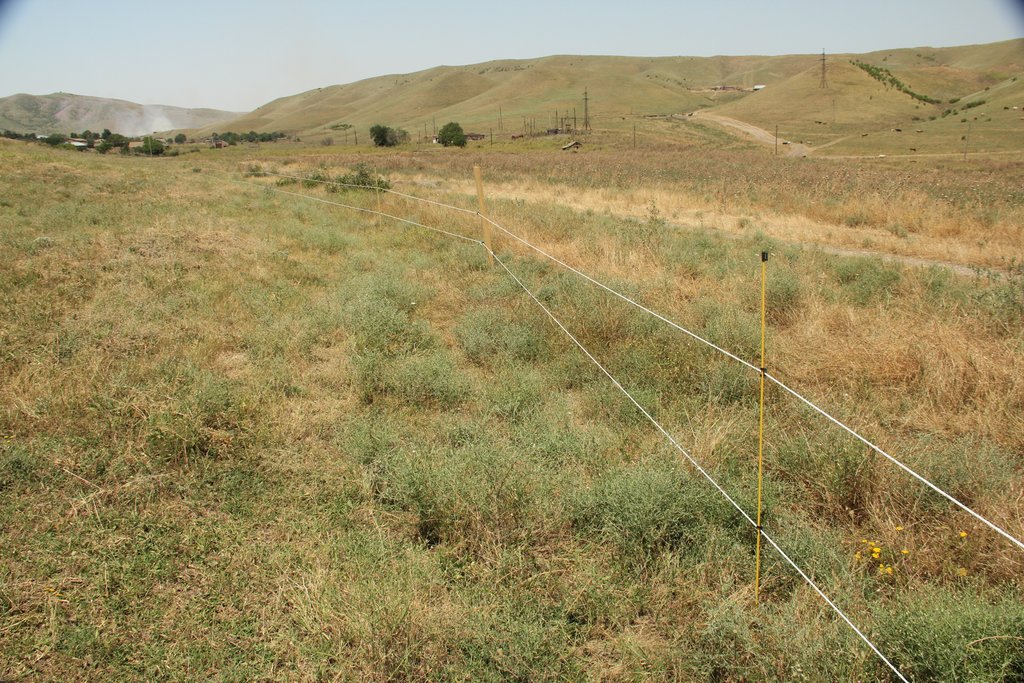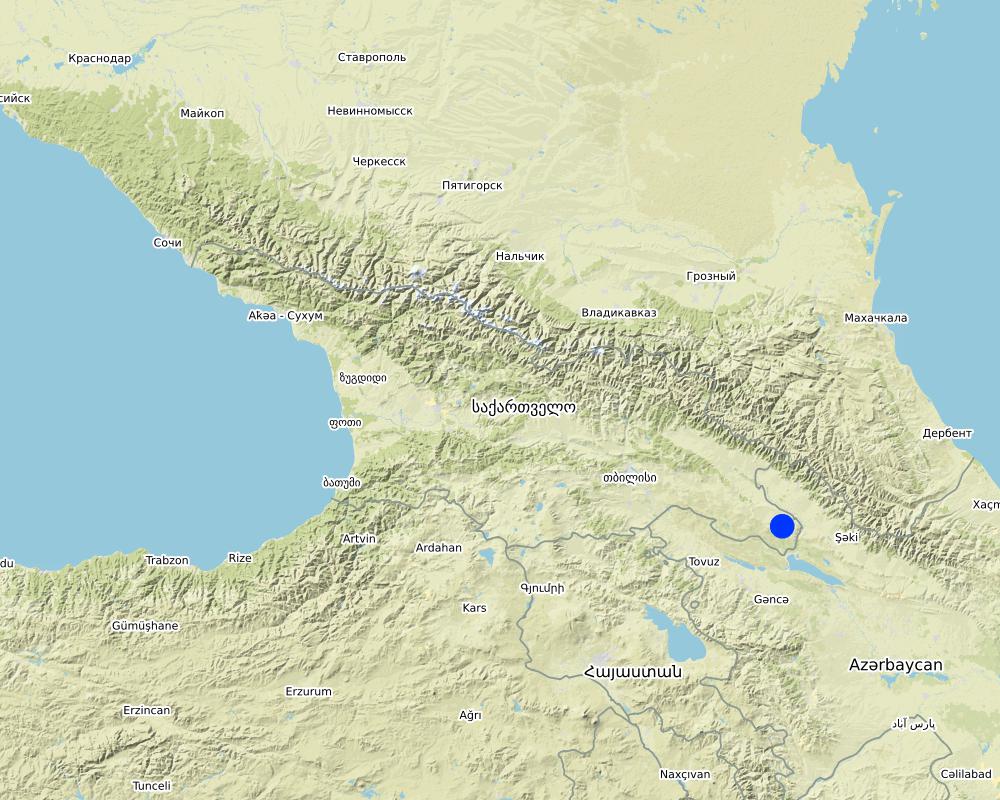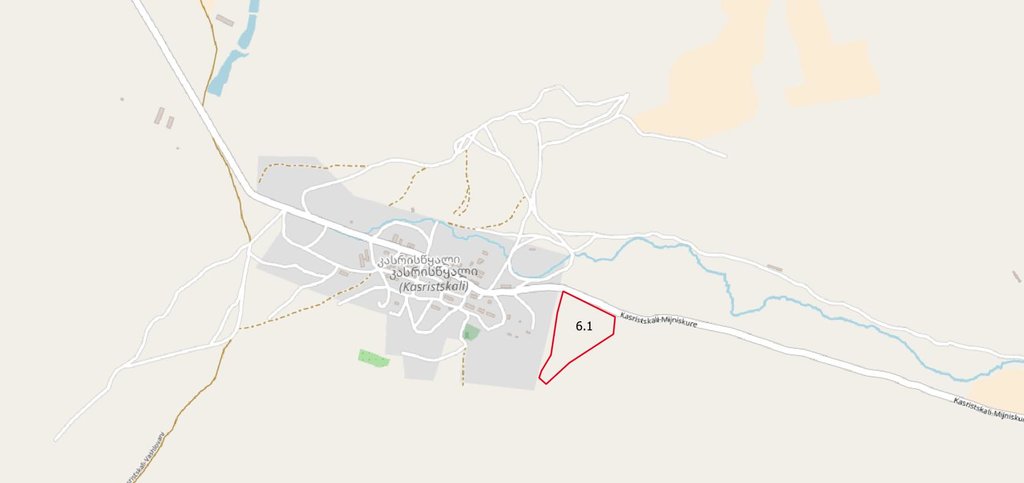Establishment of a paddock system and improvement of degraded pastureland. [จอร์เจีย]
- ผู้สร้างสรรค์:
- การอัพเดท:
- ผู้รวบรวม: Hanns Kirchmeir
- ผู้เรียบเรียง: Kety Tsereteli
- ผู้ตรวจสอบ: Rima Mekdaschi Studer
technologies_4276 - จอร์เจีย
ดูส่วนย่อย
ขยายทั้งหมด ย่อทั้งหมด1. ข้อมูลทั่วไป
1.2 รายละเอียดที่ติดต่อได้ของผู้รวบรวมและองค์กรที่เกี่ยวข้องในการประเมินและการจัดเตรียมทำเอกสารของเทคโนโลยี
co-compiler:
ชื่อของโครงการซึ่งอำนวยความสะดวกในการทำเอกสารหรือการประเมินเทคโนโลยี (ถ้าเกี่ยวข้อง)
Applying Landscape and Sustainable Land Management (L-SLM) for mitigating land degradation and contributing to poverty reduction in rural area (L-SLM Project)ชื่อขององค์กรซึ่งอำนวยความสะดวกในการทำเอกสารหรือการประเมินเทคโนโลยี (ถ้าเกี่ยวข้อง)
Regional Environmental Centre for the Caucasus (REC Caucasus) - จอร์เจีย1.3 เงื่อนไขการใช้ข้อมูลที่ได้บันทึกผ่านทาง WOCAT
ผู้รวบรวมและวิทยากรหลักยอมรับเงื่อนไขเกี่ยวกับการใช้ข้อมูลที่ถูกบันทึกผ่านทาง WOCAT:
ใช่
1.4 การเปิดเผยเรื่องความยั่งยืนของเทคโนโลยีที่ได้อธิบายไว้
เทคโนโลยีที่ได้อธิบายไว้นี้เป็นปัญหาของความเสื่อมโทรมโทรมของที่ดินหรือไม่ จึงไม่ได้รับการยอมรับว่าเป็นเทคโนโลยีเพื่อการจัดการที่ดินอย่างยั่งยืน:
ไม่ใช่
1.5 Reference to Questionnaire(s) on SLM Approaches (documented using WOCAT)
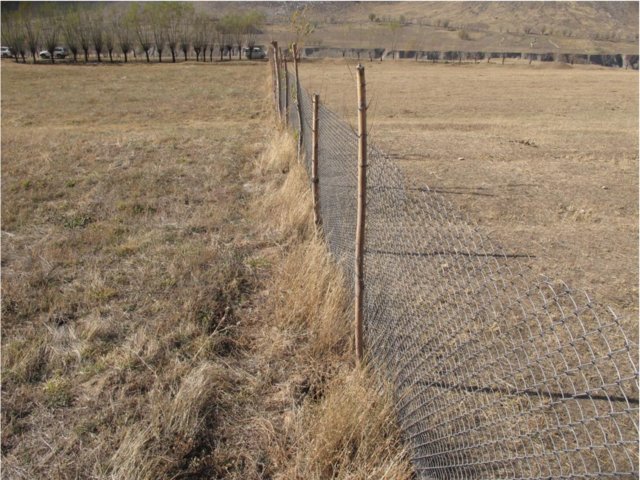
Rehabilitation of Pasture Land through fencing [ทาจิกิสถาน]
The approach demonstrates the effect and importance of rotational grazing by fencing certain areas of land in pasture areas as well as it demonstrates the rehabilitation process in comparison to the open space which is overgrazed. The approach involves mobilizing communities to observe the rehabilitation process by not grasing in …
- ผู้รวบรวม: Askarsho Zevarshoev
2. การอธิบายลักษณะของเทคโนโลยี SLM
2.1 การอธิบายแบบสั้น ๆ ของเทคโนโลยี
คำจำกัดความของเทคโนโลยี:
In a pilot project, degraded pastureland near the settlement of Kasristskali was regenerated by introducing a fencing, mowing and grazing regime that favours the growth of forage plants instead of weeds and, where necessary, reseeding forage plants.
2.2 การอธิบายแบบละเอียดของเทคโนโลยี
คำอธิบาย:
This showcase is part of the project "Applying Landscape and Sustainable Land Management (L-SLM) for mitigating land degradation and contributing to poverty reduction in rural areas", implemented by the Regional Environmental Center for the Caucasus (REC C).
The implementation site was selected by national experts together with stakeholders from the village. This site is located close to the settlement Kasristskali. It is community pastureland, which was abandoned and not maintained for many years. The site had been dominated by thistles and weeds before the intervention took place and was not suitable for grazing. 30% of the area was previously used to store manure and is rich in nutrients. To reclaim the pastureland for cattle, an area of 6.1 ha was mowed twice and equipped with an electric fence (two lines of electric wire and a solar-powered energizer brand Voss). This was done to regenerate the area so that a grazing regime could be introduced later. An electric fence was chosen because wood is not available in the area and a wire mesh fence would be more expensive. Furthermore, an electric fence is flexibly adjustable, which is essential for a rotational grazing system. It is important to remove the residues after the mowing to reduce the amount of weed seed. The time of mowing should be before the flowering of the most common weed species. An ongoing mowing and grazing regime was set up to favour fodder plants instead of weeds: Since the cows only eat the fodder plants and leave the weeds standing, the weeds have a clear advantage. To counteract this, the weeds are mowed, and fodder plants are sown. Mowing is needed for the first 2 years and after that, it is enough to control the quality of pastureland by a grazing system. For maintenance purposes, the area was cut once in early spring and a second time in summer. The evaluation in September, after the pastureland was recultivated, showed that the northern and eastern parts now have a grass and herb cover suitable for grazing, while the central, western and southern parts are still overgrown by weeds. This is due to the fact that these parts were very rich in nutrients from the very beginning and consisted exclusively of thistles. In order to improve the productivity of the site, it is recommended to cut the vegetation again in autumn, remove the residues, open the soil with a harrow and sow a pasture seed mixture adapted to the climatic conditions in February.
The local community farmers were involved in all activities. They were participated in development of local pasture management plan. The plan was approved by the community members and they are ready to follow the applied methodology and maintain the pastureland after the project completion. The farmers acknowledged the benefit from the proposed methodology and they invested to rehabilitate the additional area (6 ha) of pastureland with their own financial sources.
The 6.1 ha plot which was restored as pastureland with this technology is planned to be used as a paddock for alternating grazing between free-range and the paddock.
2.3 รูปภาพของเทคโนโลยี
2.5 ประเทศภูมิภาค หรือสถานที่ตั้งที่เทคโนโลยีได้นำไปใช้และได้รับการครอบคลุมโดยการประเมินนี้
ประเทศ:
จอร์เจีย
ภูมิภาค/รัฐ/จังหวัด:
Kakheti
ข้อมูลจำเพาะเพิ่มเติมของสถานที่ตั้ง :
Municpalty of Akhmeta, Kasristskali village
ระบุการกระจายตัวของเทคโนโลยี:
- ใช้ ณ จุดที่เฉพาะเจาะจงหรือเน้นไปยังบริเวณพื้นที่ขนาดเล็ก
Is/are the technology site(s) located in a permanently protected area?
ไม่ใช่
แสดงความคิดเห็น:
The national park Vashlovani is nearby.
Map
×2.6 วันที่การดำเนินการ
ระบุปีที่ใช้:
2018
2.7 คำแนะนำของเทคโนโลยี
ให้ระบุว่าเทคโนโลยีถูกแนะนำเข้ามาอย่างไร:
- ทางโครงการหรือจากภายนอก
ความคิดเห็น (ประเภทของโครงการ เป็นต้น) :
Applying Landscape and Sustainable Land Management (L-SLM) for mitigating land degradation and contributing to poverty reduction in rural areas; GEF funded, implementation by the Regional Environmental Center for the Caucasus (REC).
3. การจัดประเภทของเทคโนโลยี SLM
3.1 วัตถุประสงค์หลักของเทคโนโลยี
- ปรับปรุงการผลิตให้ดีขึ้น
- ลด ป้องกัน ฟื้นฟู การเสื่อมโทรมของที่ดิน
3.2 ประเภทของการใช้ที่ดินในปัจจุบันที่ได้นำเทคโนโลยีไปใช้
Land use mixed within the same land unit:
ไม่ใช่

ที่ดินที่ไม่ให้ผลผลิต
ระบุ:
The area east of the village is rich in nutrients but was not maintained. A dense weed layer of milk thistle (Silybum marianum) was established.
แสดงความคิดเห็น:
The main income of the village comes from agriculture in the plains of Shiraki Valley and livestock breeding in the hilly land east of the plains.
3.3 Has land use changed due to the implementation of the Technology?
Has land use changed due to the implementation of the Technology?
- Yes (Please fill out the questions below with regard to the land use before implementation of the Technology)
Land use mixed within the same land unit:
ไม่ใช่

ทุ่งหญ้าเลี้ยงสัตว์
ทุ่งหญ้าเลี้ยงสัตว์ที่มีการจัดการแบบเข้มข้นหรือการผลิตอาหารสัตว์:
- ทุ่งหญ้าเลี้ยงสัตว์ที่ได้มีการปรับปรุง (Improved pastures)
Animal type:
- cattle - dairy
- cattle - non-dairy beef
Is integrated crop-livestock management practiced?
ไม่ใช่
ผลิตภัณฑ์และบริการ:
- meat
- milk
Species:
cattle - dairy and beef (e.g. zebu)
แสดงความคิดเห็น:
The 6.1 ha plot which was restored as pastureland with this technology is planned to be used as a paddock for alternating grazing between free range and the paddock.
3.4 การใช้น้ำ
การใช้น้ำของที่ดินที่มีการใช้เทคโนโลยีอยู่:
- จากน้ำฝน
3.5 กลุ่ม SLM ที่ตรงกับเทคโนโลยีนี้
- การปิดล้อมพื้นที่ (หยุดการใช้ประโยชน์ สนับสนุนการฟื้นฟู)
- การจัดการปศุสัตว์และทุ่งหญ้าเลี้ยงสัตว์
3.6 มาตรการ SLM ที่ประกอบกันเป็นเทคโนโลยี

มาตรการจัดการพืช
- A7: Others

มาตรการอนุรักษ์ด้วยวิธีพืช
- V2: หญ้าและไม้ยืนต้น
- V4: การแทนที่หรือการนำพันธุ์ต่างถิ่น/ที่รุกล้ำเข้ามา ออกไปจากพื้นที่

มาตรการอนุรักษ์ด้วยการจัดการ
- M2: การเปลี่ยนแปลงของการจัดการหรือระดับความเข้มข้น
- M5: การควบคุมหรือการเปลี่ยนแปลงขององค์ประกอบของชนิดพันธุ์
- M7: อื่นๆ
แสดงความคิดเห็น:
The technology enables efficient weed control on common pasture land. The improvement of degraded pastures is achieved through weed control and sowing of fodder crops and the use of a rotational grazing system.
3.7 รูปแบบหลักของการเสื่อมโทรมของที่ดินที่ได้รับการแก้ไขโดยเทคโนโลยี

การเสื่อมโทรมของดินทางด้านชีวภาพ
- Bs (Quality and species composition): องค์ประกอบหรือความหลากหลายทางคุณภาพและชนิดพันธุ์ลดลง
- Bp (Increase of pests/diseases): การเพิ่มขึ้นของศัตรูพืชและโรคพืช
แสดงความคิดเห็น:
The degradation is driven by excessive spread of milk-thistles on nutrient rich pasture land because of missing maintenance. Those thistle stand are of low plant diversity and have no fodder value.
3.8 การป้องกัน การลดลง หรือการฟื้นฟูความเสื่อมโทรมของที่ดิน
ระบุเป้าหมายของเทคโนโลยีกับความเสื่อมโทรมของที่ดิน:
- ฟื้นฟูบำบัดที่ดินที่เสื่อมโทรมลงอย่างมาก
แสดงความคิดเห็น:
The technology supports the restoration of the weed dominated pasture land. This will increase biodiversity and productivity.
4. ข้อมูลจำเพาะด้านเทคนิค กิจกรรมการนำไปปฏิบัติใช้ ปัจจัยนำเข้า และค่าใช้จ่าย
4.1 แบบแปลนทางเทคนิคของเทคโนโลยี
ข้อมูลจำเพาะด้านเทคนิค (แบบแปลนทางเทคนิคของเทคโนโลยี):
The area on which the technology is applied is 6.1 ha. The paddock is on community rangeland and managed by the village people. It is located on a slightly north-oriented slope near the village. The area was used to store manure. The high nutrition values led to the enormous growth of weeds, especially thistles.
ผู้เขียน:
Hanns Kirchmeir
วันที่:
22/03/2019
4.2 ข้อมูลทั่วไปเกี่ยวกับการคำนวณปัจจัยนำเข้าและค่าใช้จ่าย
ให้ระบุว่าค่าใช้จ่ายและปัจจัยนำเข้าได้รับการคำนวณอย่างไร:
- ต่อพื้นที่ที่ใช้เทคโนโลยี
ระบุขนาดและหน่วยพื้นที่:
ha
ระบุสกุลเงินที่ใช้คำนวณค่าใช้จ่าย:
- USD
ระบุค่าเฉลี่ยของค่าจ้างในการจ้างแรงงานต่อวัน:
13 USD/day
4.3 กิจกรรมเพื่อการจัดตั้ง
| กิจกรรม | Timing (season) | |
|---|---|---|
| 1. | First mowing of the site, clearing from thistles and removal of hay/residuals | Early spring (March) |
| 2. | Establishment of electric fence | June |
| 3. | Opening the soil with a harrow | February of following year |
| 4. | Seeding of fodder plants | February of following year |
แสดงความคิดเห็น:
It is important to remove the residues after mowing to reduce the amount of weed seed. The time of mowing should be before the flowering of the most common weed species.
4.4 ค่าใช้จ่ายของปัจจัยนำเข้าที่จำเป็นสำหรับการจัดตั้ง
| ปัจจัยนำเข้า | หน่วย | ปริมาณ | ค่าใช้จ่ายต่อหน่วย | ค่าใช้จ่ายทั้งหมดต่อปัจจัยนำเข้า | %ของค่าใช้จ่ายที่ก่อให้เกิดขึ้นโดยผู้ใช้ที่ดิน | |
|---|---|---|---|---|---|---|
| แรงงาน | Setup of fence | person-days | 2.0 | 13.0 | 26.0 | |
| แรงงาน | Open the soil with a harrow | person-days | 1.0 | 13.0 | 13.0 | |
| แรงงาน | Seeding of fodder plants | person-days | 1.0 | 13.0 | 13.0 | |
| แรงงาน | Mowing (1st time) an manual removal of thistles | person-days | 18.0 | 13.0 | 234.0 | |
| อุปกรณ์ | Equipment for 1200m electric fence including energizer | set | 1.0 | 2547.0 | 2547.0 | |
| อุปกรณ์ | Machinery for mowing (rental) | days | 1.0 | 400.0 | 400.0 | |
| อุปกรณ์ | Machinery for harrowing (rental) | days | 1.0 | 400.0 | 400.0 | |
| วัสดุด้านพืช | Seeds (Onobrychis) | kg | 300.0 | 1.5 | 450.0 | |
| ค่าใช้จ่ายทั้งหมดของการจัดตั้งเทคโนโลยี | 4083.0 | |||||
| Total costs for establishment of the Technology in USD | 4083.0 | |||||
ถ้าผู้ใช้ที่ดินรับภาระน้อยกว่า 100% ของค่าใช้จ่าย ให้ระบุว่าใครเป็นผู้รับผิดชอบส่วนที่เหลือ:
The equipment, renting cost of machines and labor was financed by the GEF SLM project.
แสดงความคิดเห็น:
The local village is very poor and lacks of infrastructure and financial capabilities.
4.5 การบำรุงรักษาสภาพหรือกิจกรรมที่เกิดขึ้นเป็นประจำ
| กิจกรรม | ช่วงระยะเวลา/ความถี่ | |
|---|---|---|
| 1. | Second mowing and removal of hay | July |
| 2. | Third mowing and removal of hay | September |
แสดงความคิดเห็น:
The weed population is still very high. These are poisonous or spicy plant species which cannot be controlled by intensive grazing. To reduce the dominance of this weed, it is recommended to mow the entire area of 6.1 ha three times a year. The best time to mow is before the weed blossoms.
4.6 ค่าใช้จ่ายของปัจจัยนำเข้าและกิจกรรมที่เกิดขึ้นเป็นประจำที่ต้องการการบำรุงรักษา (ต่อปี)
| ปัจจัยนำเข้า | หน่วย | ปริมาณ | ค่าใช้จ่ายต่อหน่วย | ค่าใช้จ่ายทั้งหมดต่อปัจจัยนำเข้า | %ของค่าใช้จ่ายที่ก่อให้เกิดขึ้นโดยผู้ใช้ที่ดิน | |
|---|---|---|---|---|---|---|
| แรงงาน | Mowing (2nd and 3rd time) | person-days | 2.0 | 13.0 | 26.0 | |
| อุปกรณ์ | Machinery for mowing (rental) | days | 2.0 | 400.0 | 800.0 | |
| ค่าใช้จ่ายทั้งหมดของการบำรุงรักษาสภาพเทคโนโลยี | 826.0 | |||||
| Total costs for maintenance of the Technology in USD | 826.0 | |||||
แสดงความคิดเห็น:
The community is very poor so the costs for maintenance was covered by the project. After the difficult removal of the thistles, the second and third mowing was done only by machinery and has not needed that much man power than the first time.
4.7 ปัจจัยสำคัญที่สุดที่มีผลกระทบต่อค่าใช้จ่าย
ปัจจัยสำคัญที่สุดที่มีผลกระทบต่อค่าใช้จ่ายต่างๆ:
The most important factor was the equipment for the electric fence. Electric fencing material is not common in Georgia and there are no relevant national suppliers.
5. สิ่งแวดล้อมทางธรรมชาติและของมนุษย์
5.1 ภูมิอากาศ
ฝนประจำปี
- < 250 ม.ม.
- 251-500 ม.ม.
- 501-750 ม.ม.
- 751-1,000 ม.ม.
- 1,001-1,500 ม.ม.
- 1,501-2,000 ม.ม.
- 2,001-3,000 ม.ม.
- 3,001-4,000 ม.ม.
- > 4,000 ม.ม.
ระบุปริมาณน้ำฝนเฉลี่ยรายปี (ถ้ารู้) :หน่วย ม.ม.
697.00
ข้อมูลจำเพาะ/ความคิดเห็นเรื่องปริมาณน้ำฝน:
The driest month is January, with 25 mm of rainfall. The greatest amount of precipitation occurs in June, with an average of 108 mm. The difference in precipitation between the driest month and the wettest month is 83 mm.
ระบุชื่อของสถานีตรวดวัดอากาศที่ใช้อ้างอิงคือ:
Dedoplistskaro Met. Station
เขตภูมิอากาศเกษตร
- กึ่งแห้งแล้ง
The climate is warm and temperate in Dedoplistskaro. The average annual temperature in Dedoplistskaro is 11.3 °C. The warmest month of the year is July, with an average temperature of 22.7 °C. The lowest average temperatures in the year occur in January, when it is around 0.1 °C.
5.2 สภาพภูมิประเทศ
ค่าเฉลี่ยความลาดชัน:
- ราบเรียบ (0-2%)
- ลาดที่ไม่ชัน (3-5%)
- ปานกลาง (6-10%)
- เป็นลูกคลื่น (11-15%)
- เป็นเนิน (16-30%)
- ชัน (31-60%)
- ชันมาก (>60%)
ธรณีสัณฐาน:
- ที่ราบสูง/ที่ราบ
- สันเขา
- ไหล่เขา
- ไหล่เนินเขา
- ตีนเนิน
- หุบเขา
ระดับความสูง:
- 0-100 เมตร
- 101-500 เมตร
- 501-1,000 เมตร
- 1,001-1,500 เมตร
- 1,501-2,000 เมตร
- 2,001-2,500 เมตร
- 2,501-3,000 เมตร
- 3,001-4,000 เมตร
- > 4,000 เมตร
ให้ระบุถ้าเทคโนโลยีได้ถูกนำไปใช้:
- ไม่เกี่ยวข้อง
ความคิดเห็นและข้อมูลจำเพาะเพิ่มเติมเรื่องสภาพภูมิประเทศ:
The pasture is located on top of a small hill and its north-eastern slopes.
5.3 ดิน
ค่าเฉลี่ยความลึกของดิน:
- ตื้นมาก (0-20 ซ.ม.)
- ตื้น (21-50 ซ.ม.)
- ลึกปานกลาง (51-80 ซ.ม.)
- ลึก (81-120 ซ.ม.)
- ลึกมาก (>120 ซ.ม.)
เนื้อดิน (ดินชั้นบน):
- ละเอียด/หนัก (ดินเหนียว)
เนื้อดินล่าง (> 20 ซ.ม.ต่ำจากผิวดิน):
- ละเอียด/หนัก (ดินเหนียว)
อินทรียวัตถุในดิน:
- สูง (>3%)
(ถ้ามี) ให้แนบคำอธิบายเรื่องดินแบบเต็มหรือระบุข้อมูลที่มีอยู่ เช่น ชนิดของดิน ค่า pH ของดินหรือความเป็นกรดของดิน ความสามารถในการแลกเปลี่ยนประจุบวก ไนโตรเจน ความเค็ม เป็นต้น:
30% of area was used of manure storage before and is rich on nutrients.
5.4 ความเป็นประโยชน์และคุณภาพของน้ำ
ระดับน้ำใต้ดิน:
5-50 เมตร
น้ำไหลบ่าที่ผิวดิน:
ไม่ดีหรือไม่มีเลย
คุณภาพน้ำ (ที่ยังไม่ได้บำบัด):
เป็นน้ำเพื่อการดื่มที่ไม่ดี (จำเป็นต้องได้รับการบำบัด)
Water quality refers to:
ground water
ความเค็มของน้ำเป็นปัญหาหรือไม่:
ไม่ใช่
กำลังเกิดน้ำท่วมในพื้นที่หรือไม่:
ไม่ใช่
5.5 ความหลากหลายทางชีวภาพ
ความหลากหลายทางชนิดพันธุ์:
- ต่ำ
ความหลากหลายของแหล่งที่อยู่:
- ต่ำ
ความคิดเห็นและข้อมูลจำเพาะเพิ่มเติมของความหลากหลายทางชีวภาพ:
Only a few weed species where dominating the area before the intervention.
5.6 ลักษณะของผู้ใช้ที่ดินที่นำเทคโนโลยีไปปฏิบัติใช้
อยู่กับที่หรือเร่ร่อน:
- อยู่กับที่
แนวทางการตลาดของระบบการผลิต:
- mixed (subsistence/ commercial)
รายได้ที่มาจากนอกฟาร์ม:
- < 10% ของรายได้ทั้งหมด
ระดับของความมั่งคั่งโดยเปรียบเทียบ:
- จน
เป็นรายบุคคล/ครัวเรือน:
- เป็นรายบุคคล/ครัวเรือน
ระดับของการใช้เครื่องจักรกล:
- การใช้เครื่องจักรหรือเครื่องยนต์
เพศ:
- ชาย
อายุของผู้ใช้ที่ดิน:
- วัยกลางคน
ระบุลักษณะอื่นๆที่เกี่ยวข้องของผู้ใช้ที่ดิน:
The village is very remote. Driving distance to the municipality is about 1h on bad roads.
5.7 Average area of land used by land users applying the Technology
- < 0.5 เฮกตาร์
- 0.5-1 เฮกตาร์
- 1-2 เฮกตาร์
- 2-5 เฮกตาร์
- 5-15 เฮกตาร์
- 15-50 เฮกตาร์
- 50-100 เฮกตาร์
- 100-500 เฮกตาร์
- 500-1,000 เฮกตาร์
- 1,000-10,000 เฮกตาร์
- >10,000 เฮกตาร์
พิจารณาว่าเป็นขนาดเล็ก กลาง หรือขนาดใหญ่ (ซึ่งอ้างอิงถึงบริบทระดับท้องถิ่น):
- ขนาดเล็ก
5.8 กรรมสิทธิ์ในที่ดิน สิทธิในการใช้ที่ดินและสิทธิในการใช้น้ำ
กรรมสิทธิ์ในที่ดิน:
- เป็นแบบชุมชนหรือหมู่บ้าน
สิทธิในการใช้ที่ดิน:
- เข้าถึงได้แบบเปิด (ไม่ได้จัดระเบียบ)
สิทธิในการใช้น้ำ:
- เข้าถึงได้แบบเปิด (ไม่ได้จัดระเบียบ)
Are land use rights based on a traditional legal system?
ใช่
ระบุ:
Community pasture land.
5.9 การเข้าถึงบริการและโครงสร้างพื้นฐาน
สุขภาพ:
- จน
- ปานกลาง
- ดี
การศึกษา:
- จน
- ปานกลาง
- ดี
ความช่วยเหลือทางด้านเทคนิค:
- จน
- ปานกลาง
- ดี
การจ้างงาน (เช่น ภายนอกฟาร์ม):
- จน
- ปานกลาง
- ดี
ตลาด:
- จน
- ปานกลาง
- ดี
พลังงาน:
- จน
- ปานกลาง
- ดี
ถนนและการขนส่ง:
- จน
- ปานกลาง
- ดี
น้ำดื่มและการสุขาภิบาล:
- จน
- ปานกลาง
- ดี
บริการด้านการเงิน:
- จน
- ปานกลาง
- ดี
6. ผลกระทบและสรุปคำบอกกล่าว
6.1 ผลกระทบในพื้นที่ดำเนินการ (On-site) จากการใช้เทคโนโลยี
ผลกระทบทางด้านเศรษฐกิจและสังคม
การผลิต
การผลิตพืชที่ใช้เลี้ยงปศุสัตว์
จำนวนก่อน SLM:
0
หลังจาก SLM:
1-2 t/ha
แสดงความคิดเห็น/ระบุ:
The fodder production will increase in the next few years as mowing and grazing affect weed control.
คุณภาพพืชที่ใช้เลี้ยงปศุสัตว์
แสดงความคิดเห็น/ระบุ:
The fodder production will increase within the next years when mowing and grazing shows effect in the decrease of weeds.
พื้นที่สำหรับการผลิต
จำนวนก่อน SLM:
0 ha
หลังจาก SLM:
6 ha
แสดงความคิดเห็น/ระบุ:
6 ha of degraded and unused pastureland have been recultivated.
รายได้และค่าใช้จ่าย
ค่าใช่จ่ายของปัจจัยการผลิตทางการเกษตร
แสดงความคิดเห็น/ระบุ:
Community is equipped with electric fencing infrastructure (including training)
Specify assessment of on-site impacts (measurements):
Most of the area could not be used for cattle grazing due to the dominance of weeds. Based on biomass harvesting experiments in Tusheti, it is expected that at least 1-2 tons of fodder per hectare will be available on the pasture.
6.2 ผลกระทบนอกพื้นที่ดำเนินการ (Off-site) จากการใช้เทคโนโลยี
Specify assessment of off-site impacts (measurements):
No significant effects are expected off-site
6.3 การเผชิญและความตอบสนองของเทคโนโลยีต่อการเปลี่ยนแปลงสภาพภูมิอากาศที่ค่อยเป็นค่อยไป และสภาพรุนแรงของภูมิอากาศ / ภัยพิบัติ (ที่รับรู้ได้โดยผู้ใช้ที่ดิน)
การเปลี่ยนแปลงสภาพภูมิอากาศที่ค่อยเป็นค่อยไป
การเปลี่ยนแปลงสภาพภูมิอากาศที่ค่อยเป็นค่อยไป
| ฤดู | increase or decrease | เทคโนโลยีมีวิธีการรับมืออย่างไร | |
|---|---|---|---|
| ฝนตามฤดู | ฤดูร้อน | ลดลง | ปานกลาง |
แสดงความคิดเห็น:
When temperatures rise and precipitation decreases, productivity falls. If productivity is below 1t/ha, the investment in an electric fence will not pay off.
6.4 การวิเคราะห์ค่าใช้จ่ายและผลประโยชน์ที่ได้รับ
ผลประโยชน์ที่ได้รับเปรียบเทียบกับค่าใช้จ่ายในการจัดตั้งเป็นอย่างไร (จากมุมมองของผู้ใช้ที่ดิน)
ผลตอบแทนระยะสั้น:
ด้านลบ
ผลตอบแทนระยะยาว:
ด้านบวก
ผลประโยชน์ที่ได้รับเปรียบเทียบกับค่าใช้จ่ายในการบำรุงรักษาหรือต้นทุนที่เกิดขึ้นซ้ำอีก เป็นอย่างไร (จากมุมมองของผู้ใช้ที่ดิน)
ผลตอบแทนระยะสั้น:
ด้านลบเล็กน้อย
ผลตอบแทนระยะยาว:
ด้านบวก
แสดงความคิดเห็น:
In the first two years, the forage harvest will be low, while the costs for erecting the fence and maintenance by mowing will be high. In the long run, unproductive land will be productive again. On the 6 ha, 6 to 12 tons of biomass per year can be expected (depending on rainfall in spring and summer). This is equivalent to 500-1000 USD/year.
6.5 การปรับตัวของเทคโนโลยี
- ครั้งเดียวหรือเป็นการทดลอง
Of all those who have adopted the Technology, how many did so spontaneously, i.e. without receiving any material incentives/ payments?
- 0-10%
แสดงความคิดเห็น:
There is strong interest to establish a second plot for rotational pasture systems of 20ha near by. The financial capacity of the village is to low to cover the investment of the fencing material.
6.6 การปรับตัว
เทคโนโลยีได้รับการปรับเปลี่ยนเมื่อเร็วๆนี้ เพื่อให้ปรับตัวเข้ากับสภาพที่กำลังเปลี่ยนแปลงหรือไม่:
ไม่ใช่
6.7 จุดแข็ง / ข้อได้เปรียบ / โอกาสของเทคโนโลยี
| จุดแข็ง / ข้อได้เปรียบ / โอกาสในทัศนคติของผู้ใช้ที่ดิน |
|---|
| improved pasture quality and new fencing technology introduced |
| raised production of fodder plants |
| pasture management plan is developed and local farmers are able to manage the pasture rotational system themselves. Also the farmers were trained in installation and maintenance of el-fence. |
| จุดแข็ง / ข้อได้เปรียบ / โอกาสในทัศนคติของผู้รวบรวมหรือวิทยากรหลัก |
|---|
| A fertile land near the village, which was unusable, was turned back into productive land. |
6.8 จุดอ่อน / ข้อเสียเปรียบ / ความเสี่ยงของเทคโนโลยีและวิธีการแก้ไข
| จุดอ่อน / ข้อเสียเปรียบ / ความเสี่ยงในทัศนคติของผู้ใช้ที่ดิน | มีวิธีการแก้ไขได้อย่างไร |
|---|---|
| The pasture land has already been severely degraded (mainly by weeds) and it will take time and more resources to restore it. | Small grants to support the rental of machines for mower maintenance (topping cuts). |
| จุดอ่อน / ข้อเสียเปรียบ / ความเสี่ยงในทัศนคติของผู้รวบรวมหรือวิทยากรหลัก | มีวิธีการแก้ไขได้อย่างไร |
|---|---|
| The investments for the fencing cannot be made by the villagers. | Long-term microloans with low interest rates. |
| Seed of local, climate-adapted forage plants is not available. | Establishment of local seed suppliers in cooperation with the agricultural extension service. |
7. การอ้างอิงและการเชื่อมต่อ
7.1 วิธีการและแหล่งข้อมูล
- ไปเยี่ยมชมภาคสนาม การสำรวจพื้นที่ภาคสนาม
2 field visits in 2018
- การสัมภาษณ์กับผู้ใช้ที่ดิน
two interviews with local land users and one training on rotational pasture management, hands on training on installing and maintaining electric fence.
- การสัมภาษณ์ผู้เชี่ยวชาญด้าน SLM หรือผู้ชำนาญ
Discussion with national field experts
วันที่เก็บรวบรวมข้อมูล(ภาคสนาม) :
12/09/2018
7.2 การอ้างอิงถึงสิ่งตีพิมพ์
หัวข้อ, ผู้เขียน, ปี, หมายเลข ISBN:
Applying Landscape and Sustainable Land Management (L-SLM) for mitigating land degradation and contributing to poverty reduction in rural areas: Final report. 2017. Kirchmeir, H., Joseph, A., Huber, M
ชื่อเรื่อง ผู้เขียน ปี ISBN:
RECC Caucasus
ลิงก์และโมดูล
ขยายทั้งหมด ย่อทั้งหมดลิงก์

Rehabilitation of Pasture Land through fencing [ทาจิกิสถาน]
The approach demonstrates the effect and importance of rotational grazing by fencing certain areas of land in pasture areas as well as it demonstrates the rehabilitation process in comparison to the open space which is overgrazed. The approach involves mobilizing communities to observe the rehabilitation process by not grasing in …
- ผู้รวบรวม: Askarsho Zevarshoev
โมดูล
ไม่มีโมดูล


